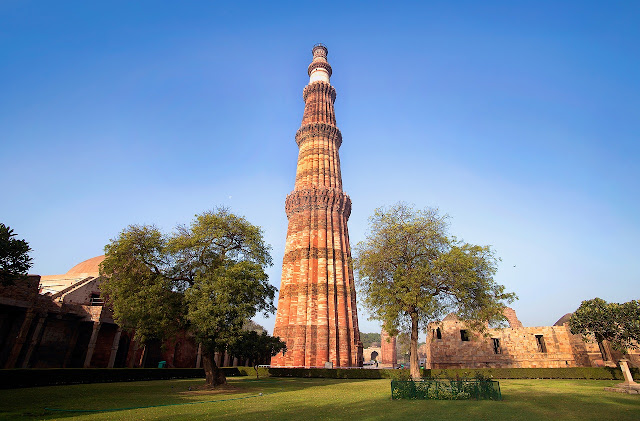Interesting facts about Qutub Minar
Qutub Minar is a UNESCO World Heritage Site located in
Delhi, India. It is a prominent historical monument known for its architectural
significance and historical importance. Here are some interesting facts about
Qutub Minar:-
1: Qutub Minar is the
tallest brick minaret in the world, standing at a height of approximately 72.5
meters (237.8 feet). It is an excellent example of early Indo-Islamic
architecture.
2: The construction of
Qutub Minar began in 1192 by Qutb-ud-din Aibak, the founder of the Delhi
Sultanate, and was completed by his successor Iltutmish. It was originally
built to celebrate their victory over Delhi's last Hindu ruler.
3: The minaret is made of
red sandstone and marble. The lower three stories are made of red sandstone,
while the fourth and fifth stories are made of marble and sandstone. These
different materials signify changes in architectural style during its
construction.
4: The exterior of the
Qutub Minar is adorned with intricate carvings and inscriptions. These carvings
include verses from the Quran and decorative motifs, showcasing the skill of
the craftsmen of that era.
5: In the courtyard of
Qutub Minar, there is a 7-meter tall iron pillar. This pillar is notable for
its rust-resistant composition and has not corroded significantly over
centuries. The exact composition of the iron remains a subject of scientific
investigation and intrigue.
6: The Qutub Minar has
faced several natural disasters and accidents over the years, including
earthquakes. It was damaged by lightning in 1369 and subsequently repaired by
Firoz Shah Tughlaq. In the 19th century, it was struck by lightning again, and
it lost its uppermost storey, which was later restored by the British.
7: Within the Qutub Minar
complex, there is the tomb of Iltutmish, the second Sultan of Delhi. This tomb
is an example of early Indo-Islamic architecture and is known for its simple
yet elegant design.
8: Qutub Minar was
designated as a UNESCO World Heritage Site in 1993, recognizing its cultural
and historical significance.
9: The minaret gets its
name from Qutb-ud-din Aibak, the Sultan who initiated its construction.
"Qutub" means "axis" or "pole," and the minaret
might have been named so because of its towering presence.
10: Qutub Minar's
architectural style has influenced subsequent buildings in the Delhi Sultanate
and the Mughal Empire. It served as a precursor to many other Indo-Islamic
architectural wonders, including the famous Taj Mahal.
11: While the Qutub Minar
is often associated with religious and commemorative purposes, some historians
suggest that it may have also been used as a watchtower.
12: Visitors can enjoy a
light and sound show in the evening at the Qutub Minar complex, which narrates
the history of the monument and the surrounding area.
Qutub Minar continues to attract tourists and history enthusiasts
from around the world, offering a glimpse into the rich history and
architectural heritage of India.


